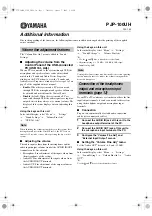
79
Data Communication
SH-05F_E_09.fm
[79/81]
*9 Set the virtual connection with a serial cable and interconnect
between devices.
*10 Transfer phonebook data on the handset memory to a
Bluetooth device. Data may not be displayed correctly on the
other party’s device depending on the contents of the
transferred phonebook data.
*11 Join a PC network etc. and share the Internet connection.
*12 Communicate data with a commercially available health
appliance compatible with Bluetooth such as a weighing
machine.
*13 Make a Bluetooth device ring or vibrate when the Bluetooth
connection is terminated after it is moved away from the
handset.
*14 Make the handset/a Bluetooth device ring or vibrate by
operating the handset/the Bluetooth device.
*15 Notify you of incoming calls, new mails, etc. through a
Bluetooth device.
*16 Stop the ringtone or the vibrator of the handset by operating a
Bluetooth device.
*17 Synchronize clocks between a Bluetooth device and the
handset.
To register/connect a Bluetooth device, the Bluetooth passkey
may need to be entered. Before starting the registration, decide
one- to sixteen-digit number. Enter the same number on the
handset and the other party’s Bluetooth device.
Set the other party’s Bluetooth device to the registration stand-by
status in advance.
1
In the home screen, [APPS]
/
[Settings]
/
[Bluetooth]
2
Slide [OFF] to the right
3
Select a Bluetooth device
/
[Pair]
:
The confirmation screen for connection may be displayed.
:
Entering the Bluetooth passkey may be necessary
depending on the other party’s Bluetooth device. Also, some
Bluetooth devices may start connecting after completing
registration.
Refer to the manual for the Bluetooth device as well.
The settings of access points for DUN profile can be changed
from a Bluetooth device such as a PC or car navigation system.
If connection to an access point via DUN profile becomes
unavailable, it is recommended to initialize access points
(
n
P. 23 “Resetting an access point”).
You may not hear TV audio etc. with Bluetooth devices which
are not compatible with SCMS-T.
Precautions about handling Bluetooth devices
Note the followings when using Bluetooth devices.
Note the followings to make good connection.
Keep the distance between the handset and another
Bluetooth device within approximately 10 m with no
obstructions in sight. The distance within which you can
make connection may be shorter when there are
obstructions between them or depending on the conditions
of the surroundings (such as walls or furniture) and the
structure of a building. Especially when there is a wall or
floor of reinforced concrete between them, they may be
unable to connect with each other. Note the above
mentioned distance is not guaranteed.
Move the handset and another Bluetooth device as far away
as possible from home electric appliances, AV devices, OA
devices, etc. before connection. Bluetooth devices are liable
to be adversely affected by a microwave oven, so move
them as far away as possible from the microwave oven
while using them. Otherwise, normal connection cannot be
performed when other electric devices are powered on or
Bluetooth devices may cause noises or reception failure on
a TV or radio set.
Move the Bluetooth device to a place where connection is
possible when there is a broadcast station or radio near the
Bluetooth device and the handset cannot be connected to
the device. Strong radio waves may prevent connection
between Bluetooth devices.
Wireless connection is available with Bluetooth devices put
in a bag or pocket. However, lowering of communication
speed or noise may result when you are in between the
Bluetooth device and the handset.
Electromagnetic signals from Bluetooth devices may affect the
operation of electronic medical equipment etc. As some cases
may result in accident, turn off the handset and other Bluetooth
devices in the following places.
On trains
On airplanes
In hospitals
Near automatic doors or fire alarms
In places such as gas stations where flammable gas is
generated
Radio interference with Wi-Fi compatible devices
The Bluetooth devices use the same frequency band (2.4
GHz) as wireless LANs (IEEE 802.11b/g/n). Therefore, using a
Bluetooth device near a wireless LAN device may cause the
radio interference, lowering of communication speed, noise or
connection failure. In this case, turn off the wireless LAN
device or keep the handset and the Bluetooth device at least
approximately 10 m away from the wireless LAN.
Using Bluetooth function
SH-05F_E.book 79 ページ 2014年6月5日 木曜日 午後4時15分
















































